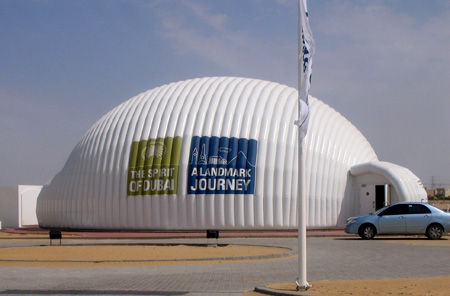Inflatable building
Inflatable buildings are constructed using two layers of membrane connected together to form inflatable 'cushions'. Membranes are usually less than 1 mm thick, and air is used to pressurise the cavity between them to form a 'rigid', structurally stable element, capable of spanning large distances.
Inflatable buildings differ from air-supported buildings, which are formed by a single-layer membrane that is supported by pressurisation of the whole interior of the building. An air-supported building prevents air from being lost when access points are opened by using airlocks, which maintain the level of air pressure inside the occupied space. Inflatable buildings have a lower power requirement than inflatable buildings as they require a lower volume of pressurised air.
Inflatable buildings are typically used for warehouses and other storage facilities, sports facilities, stadia, shopping centres and so on. Since the amount of material used for inflatable buildings is relatively low, they can be portable, with the air allowed to escape before the membrane is packed down to a small volume.
Inflatable structures (or inflatables) can also be used to create specific components such as; escape slides, mattresses, swimming and paddling pools, play slides, bouncy castles, and so on.
Legal requirements apply to the supply, hire and use of inflatable play equipment for commercial purposes, but not to private, domestic buyers and users. Inflatables can be dangerous in terms of user injuries as well as being unsuitable in high winds if inadequately secured.
Inflatables should be checked before buying or hiring for an event to ensure they comply with BS EN 14960. A label should provide information about when the inflatable was made, how many people can use it and their maximum heights. Once the inflatable is fully inflated, it should be inspected prior to use to check that the site is suitable, that the anchorages are secure, and the internal air pressure provides a firm footing.
[edit] Related articles on Designing Buildings Wiki
Featured articles and news
RTPI leader to become new CIOB Chief Executive Officer
Dr Victoria Hills MRTPI, FICE to take over after Caroline Gumble’s departure.
Social and affordable housing, a long term plan for delivery
The “Delivering a Decade of Renewal for Social and Affordable Housing” strategy sets out future path.
A change to adoptive architecture
Effects of global weather warming on architectural detailing, material choice and human interaction.
The proposed publicly owned and backed subsidiary of Homes England, to facilitate new homes.
How big is the problem and what can we do to mitigate the effects?
Overheating guidance and tools for building designers
A number of cool guides to help with the heat.
The UK's Modern Industrial Strategy: A 10 year plan
Previous consultation criticism, current key elements and general support with some persisting reservations.
Building Safety Regulator reforms
New roles, new staff and a new fast track service pave the way for a single construction regulator.
Architectural Technologist CPDs and Communications
CIAT CPD… and how you can do it!
Cooling centres and cool spaces
Managing extreme heat in cities by directing the public to places for heat stress relief and water sources.
Winter gardens: A brief history and warm variations
Extending the season with glass in different forms and terms.
Restoring Great Yarmouth's Winter Gardens
Transforming one of the least sustainable constructions imaginable.
Construction Skills Mission Board launch sector drive
Newly formed government and industry collaboration set strategy for recruiting an additional 100,000 construction workers a year.
New Architects Code comes into effect in September 2025
ARB Architects Code of Conduct and Practice available with ongoing consultation regarding guidance.
Welsh Skills Body (Medr) launches ambitious plan
The new skills body brings together funding and regulation of tertiary education and research for the devolved nation.
Paul Gandy FCIOB announced as next CIOB President
Former Tilbury Douglas CEO takes helm.
UK Infrastructure: A 10 Year Strategy. In brief with reactions
With the National Infrastructure and Service Transformation Authority (NISTA).























